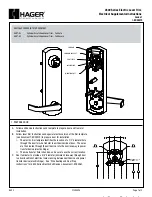
The pin to connect the liner to the shuttle lock is screwed into the thread at
the distal end of the liner.
>
Required tools and materials:
Torque Wrench (adjustable to 3 Nm), 636K13 Loctite
®
1) Apply Loctite
®
to the thread.
2)
NOTICE! Do not shorten the pin.
Screw the pin into the thread and tighten it (see fig. 17) (tightening
torque:
3 Nm
).
6 Use
CAUTION
Pin not fully inserted into the shuttle lock
Risk of falling if the pin is not engaged in the shuttle lock
►
Guide the pin into the shuttle lock according to the instructions.
►
Always verify that the pin is engaged in the shuttle lock before using
the prosthesis.
►
Inform the patient.
The liner and shuttle lock are connected to each other with the pin. The pin
engages in the shuttle lock and holds the liner in place.
Putting on the Liner
1) Check the pin and liner for damage. The pin must be flexible and always
spring back to the original position.
2)
NOTICE! Misaligning the pin leads to damage during insertion in
the shuttle lock.
Apply the liner on the end of the residual limb so that the pin is aligned
with the longitudinal axis of the residual limb.
3) Roll the liner over the residual limb.
4) Check the fit of the liner and the alignment of the pin.
Donning the Prosthetic Socket
1) With the liner, slide into the prosthetic socket until the pin slides into the
opening of the lamination adapter.
2)
INFORMATION: While the pin is being inserted, clicking noises
caused by the magnet and the ratchet unit can be heard. These
noises do not indicate whether the pin is fully engaged in the
ratchet unit.
Insert the pin fully into the shuttle lock.
3) Before using the prosthesis, verify that the pin is fully engaged in the
shuttle lock.
24 | Ottobock
Summary of Contents for 6A40
Page 2: ...1 2 3 4 5 2 Ottobock ...
Page 3: ...6 7 8 9 10 11 Ottobock 3 ...
Page 4: ...12 13 14 15 16 17 4 Ottobock ...
Page 267: ...Ottobock 267 ...
Page 268: ...268 Ottobock ...
Page 269: ...Ottobock 269 ...
















































